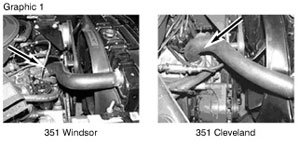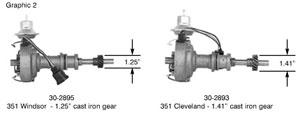Application: Ford vehicles with Windsor/Cleveland 351 (5.8L) cubic inch engines.
Problem: Interchanging or installing parts for the wrong engine.
Cause: Lack of information on Ford 351 engine differences.
Engine Differences:
The most obvious external difference is the engine valve covers. The 351W (Windsor) valve covers are attached with 6 bolts, straight front to rear, and narrow in width (similar to the 302 c.i. engine.)*
The 351C (Cleveland) valve covers are attached with 8 bolts, flat
with 2 different planes, and wider in width.
The 351W engine has a radiator hose that attaches to the intake manifold, while the 351C attaches to the engine block. (See Graphic 1). The 351W takes a 5/8” thread spark plug and the 351C takes a 14mm thread plug. (See Graphic 2).
Distributor differences:
The 351W has a smaller 1.245” diameter distributor gear, and the 351C has a larger 1.418” diameter distributor gear.
Each engine has a 5/16” oil drive at the bottom of the shaft and a 1.557” diameter housing, measuring directly above or below the O-ring area.
Note: * The Ford 302 c.i. engine has a 1/4” oil drive on the shaft, a small 1.245” diameter gear, and a smaller 1.550” diameter housing. 
Windsor 351 V-8 Engine:
- Valve cover is held in place by 6 bolts.
- Radiator hose connects to water neck on the front of the intake manifold.
The 351 Cleveland’s radiator hose attaches to the radiator and connects directly into the front of the engine block. It makes a 90° bend from the radiator to the engine block.

Cleveland 351 V-8 Engine:
- Valve cover is held in place by 8 bolts.
- Radiator hose is a 90° hose that connects directly to the top front of the engine block.
Tech Tip courtesy of CARDONE.
For additional information on products offered by CARDONE, visit www.cardone.com.













